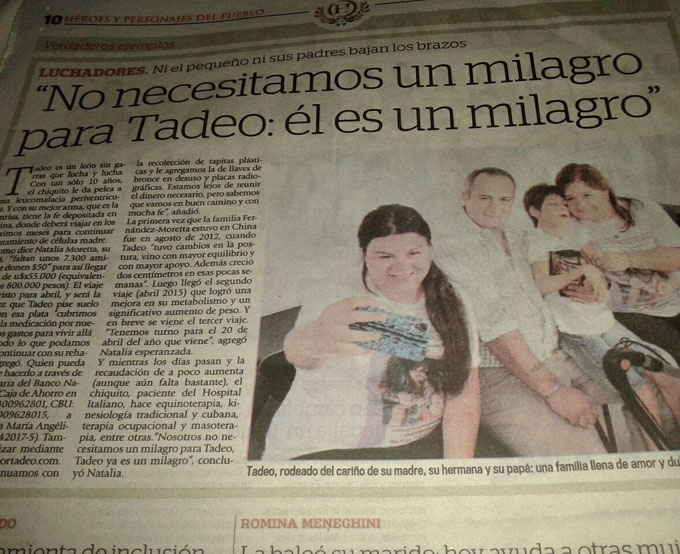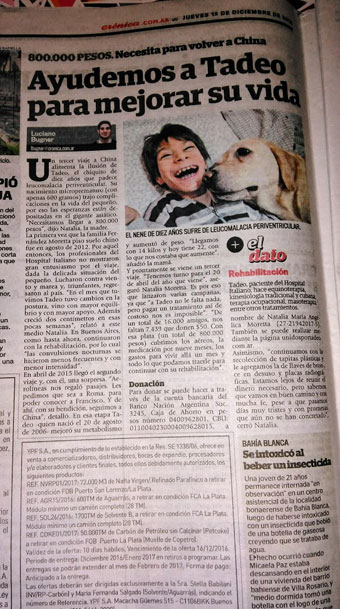Tadeo-Cerebral palsy-( Argentina )-update on Jan. 27th, 2017
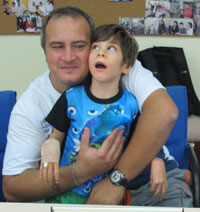 Name: TADEO EZEQUIEL FERNANDEZ MORETTA
Name: TADEO EZEQUIEL FERNANDEZ MORETTA
Sex: Male
Country: Argentina
Age: 6
Diagnosis: Cerebral palsy
Admission Date: August 10, 2012
Days Admitted to Hospital: 30
Before treatment: the patient was a premature infant born when his mother suffered from urinary infection when she was 27 weeks pregnant. He was born on August 20, 2006. He had no autonomous respiration after he was born. He was sent to CCU and received an intubation tube for respiration. He was kept on a nasogastric tube to receive nutrition. He, also, had epileptic seizures and took phenobarbital regularly. Then there was a little epileptic seizure. 9 days later, the patient had autonomous respiration. 5 months later, the patient was diagnosed with spastic quadriparesis, development delay, urinary incontinence, swallowing difficulty and renal insufficiency. The patient received symptomatic treatment. The patient suffered from muscle tone higher than normal and received Lioresal for treatment. About 2 years ago, the nasogastric tube was removed. The patient eats a semi-liquid diet by mouth. Two months ago, the patient received Clobazam to control the epilepsy. Then the patient had an obvious epileptic seizure. The muscle tone was higher than before.
Admission PE:
Br: 26/min; Hr: 94/min, Temperature: 37.5 degree. Height: 105cms, weight: 14 kgs. Skin and bones: The skin and mucosa was complete. There was vascular piebald in the skin of four limbs' distal end. Both hands and feet were ice-cold, nail bed cyanosis. The skin was light yellow stained over the whole body. There was no yellow stain in sclera. Pigeon chest; the thorax was not symmetrical. The left thorax was slightly higher than normal. The respiratory sounds in both lungs were clear, with no dry or moist rales. The heart sound was strong. The cardiac rhythm was irregular, with no obvious murmur in the valves. The abdomen was smooth. Left rectus abdominis was higher than normal and he, also, had umbilical hernia.
Nervous System Examination:
TADEO was alert. He could cry and smile. He was lacking orientation, calculation and memory. He was sensitive to sound and liable to panic when he heard a sudden sound. He could understand simple instructions. Both pupils were equal in size and round, the diameter was about 3.0mms. Both pupils were sensitive to light reflex. He was sensitive to light stimulus. He could blink quickly when receiving the examination. The movement of the eyeballs was flexible. There was no nystagmus. He could pronounce individual simple tones such as "A". He had difficulty with spoken language. The chew ability was poor and is on a mainly semi-liquid diet. He could swivel, but could not shrug his shoulders. He had difficulty with bending or stretching of upper limbs. Both hands couldn't hold objects. Both lower limbs were sensitive to kicking. He had difficulty with turning over, sitting or standing. The muscle tone of four limbs was higher than normal and had difficulty with passive activity. With some assistance, he could stand on toes. The tendon reflexes of four limbs were elicited, Bilateral abdominal reflexes was not elicited. The bilateral Achilles tendon contractures. The ankle clonus was positive. Bilateral Hoffmann sign was negative. Bilateral Babinski sign was negative. He couldn't cooperate with other examinations.
Treatment:
After admission, TADEO received the relevant examinations and was diagnosed with Cerebral palsy. The patient received treatment to improve the blood circulation in order to increase the blood supply to the damaged nerves and to nourish the neurons. He also received treatment to control epilepsy. This was combined with neurological rehabilitation treatment.
Post Treatment:
During the therapy, the epileptic seizure frequency had fluctuations. After adjusting the treatment, the epileptic seizure is under control. He has good sleep and is eating regularly. He, also, had normal urine and passing of stool. The vascular piebald in the skin of four limbs' distal end is not obvious. Both hands and feet are warm. The nail bed has no cyanosis. The light yellow stained in the whole body is alleviated. He can understand more instructions. He pays more attention to outside objects. He always watches others shift. He has lower susceptibility thresholds to sound and light. He can turn over. With some support on his back, he could sit for 5-20 minutes. With some assistance, he can stand, and both heels are 2 cm distance with the floor. He takes steps. The muscle tone of four limbs is reduced and the passive activity is easier than before. The patient's condition is better than before.
Tadeo have an interview with local media and the media report it as followings:
The second round treatment:
Date: Apr. 13th, 2015
Days Admitted to Hospital: 21 days
Before treatment:
He was a premature baby because his mother had urinary infection at 27-week of pregnancy. On Aug. 20th, 2006, he was born and he couldn’t breathe. He was send to MU and used moth-tube with ventilator to breathe. He had nasogastric tube to eat. He had epilepsy and took drimy every day. The disease was controled well. He could breathe on his own 9 days later. He was diagnosed with spastic paralysis, hypoevolutism, uracratia, dysphagia and renal inadequacy 5 months ago and had treatment. He took baclofen to treat higher muscle tension 5 years ago. He removed the nasogastric tube and ate semiliquid 4 years ago. He also took urobanyl to control his epilepsy. He did experience any epileptic attack any more. His muscle tension was higher than before. He came to our hospital 2 years ago. When he arrived, there were vascular spots on the distal limbs. Both hands and feet were cold. His nail beds were purple. His skin was light yellow. He was alert, could smile and cry. His orientation, calculation and memory were bad. He was alert to voice and he would be upset. He could understand simple commands. He was senstive to the light, when he was examined. He always winked fast, his eyeballs could move around freely. He couldn’t flex or extend his upper limbs well. Both hands couldn’t hold objects. Both lower limbs could kick freely, but he couldn’t turn over, sit or stand. The muscle tension of four limbs was higher than normal. It was hard for him to do the passive activity. He could only stand on his toes with someone’s help. After the treatment, the vascular spots on the distal limbs were less. Both hands and feet were warm. His nail beds were normal. His body was light yellow. He could understand more orders and he cared more about the environment. He always stared at someone, and he was not that sensitive. He could turn over, he could sit for 5-20 minutes with support. When he stands on the ground with someone’s help, his heels were 2cm above the ground, and he could move. The muscle tension was lower, he could do passive activity easier. His family wanted a better treatment so he came to our hospital and was diagnosed with Cerebral palsy.
His spirit was good. His diet and sleeping were good. He ate semi-liquid diet, 300ml, 4 times a day, he swallowed well. His urination and defecation were regular. He defecated 2-3 times each day. His weight was normal.
Admission PE:
Bp: 100/62mmHg; Hr: 92/min, Br: 26/min. Temperature: 36.6degrees. Height: 114cms, weight: 15kgs. He was skinny. His skin and mucosa was normal. Both hands and feet were cold. Slightly nail bed cyanosis. He had a pigeon chest. The thorax was asymmetrical. The respiratory sounds in both lungs were clear, with no dry or moist rales. The heart sound was strong. The cardiac rhythm was regular, with no obvious murmur in the valves. The abdomen was flat with muscle tension on his left rectus abdominis. He had umbilical hernia. His bilateral hip joints,knee-joints and ankle joints had contracture deformity and could not fully stretched.
Nervous System Examination:
Tadeo was alert. He could smile and cry. His orientation, memory and calculation abilities were seriously deficient. His sensitivity to the sound was reduced than last time he visited. He could follow simple instructions. Both pupils were equal in size and round, the diameter was about 3.0mms. Both pupils were normal to light reflex. Both pupils were sensitive to respond to light stimuli. He always blinked his eyes quickly during the test. The movement of both eyeballs was flexible. There was no obvious nystagmus. He could pronounce several single-tone,such as “Ah”. He could not speak. His chewing force was weak. He took semi-liquid diets. He could not shrug his shoulders. His flexion and extension movement of upper limbs was not flexible. He could not hold objects with his hands. His lower limbs pedal kick was flexible. He could not turn over,sit or stand. His muscle tones of four limbs were high. Passive activities were difficult. His toes could touch the ground with assistance. His tendon reflexes of four limbs could be elicited. Abdominal reflexes could not be elicited. His bilateral achilles's tendon had contracture. Ankle clonus were positive. Bilateral palm jaw reflex was negative. Bilateral Hoffmann sign was negative. Bilateral babinski sign was negative. He couldn’t cooperate with other examinations.
Treatment:
After admission, Tadeo received the relevant examinations, accompanied with his medical history. He was diagnosed with Cerebral palsy. The patient received treatment to improve the blood circulation in order to increase the blood supply to the damaged nerves and to nourish the neurons. He also received treatment to control his epilepsy. This was combined with neurological rehabilitation treatment.
Post-treatment:
Tadeo’s didn’t experienced an epileptic attack during the treatment. His sleeping, diet, urination and defecation were normal. His hands and feet are getting warm, his nail bed with no cyanosis. He has gained 3 kg weight. He could understand more orders and he cared more about the environment. He was not that sensitive. He could turn over, he could sit for 10-30 minutes with support. When he stands on the ground with someone’s help, his heels were 1cm above the ground, and he could move. His muscle tension was lower.
Download the Windows Media Player Firefox Plugin if you are using Firefox browser.To know more,Please read Using the Windows Media Player plugin with Firefox.
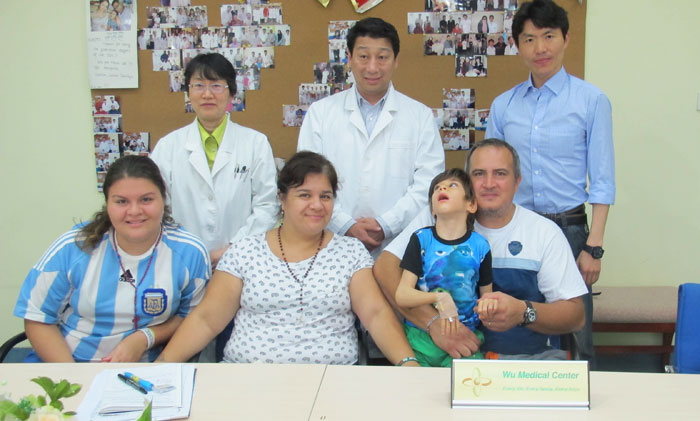
E-mail:
Date:2013-01-06
Hello Dr. Li, were with many positive changes in Tadeo.
This very attentive, his tone is altered but largely dominates their spasticity.
We are with medication problem we finished the Mecobalamin Tablets 0.5 mg. and no one gets in their chemistry and I know that change will have on daily medication Tadeo.
He also sent a video with his kine.
Enormous affection, hope returned.
Natalia Moretta
Date: 2013-04-14
Hello Dr. XI.
Sent the blood test and the result of electroencefalagrama video.
Tadeo since 2 February have fallen almost entirely seizures, we are very happy with its performance and changes.
Cognitively responds increasingly well to simple orders, muscle tone undergoes changes with your mood, but it is easier to achieve relaxation.
Here in Argentina it is very difficult to get the medication used in China, not taking vitamin B6, s end on March 25.
Here not only sell but in a compound.
No we will make botox, for your reply and your neurology of short-term changes.
Hugs and blessings!
I enclose a video of Thaddeus working with kinesiology at home
Natalia Moretta
Date:2016-1-14
Dra. Xi como estas?
Tadeo no para de crecer, mucho mejor su postura, su atención cognitiva, sin convulsiones.
Aumentando de peso ya estamos casi en 21 kg.
Felices!
Quiero contarte que terminamos con las siguientes medicaciones:
FLUNARIZINA (10-11-2015)
ORIZANOL y DONEPEZIL (11-01-16)
Y que la próxima semana mando los estudios de control.
Besos enormes!
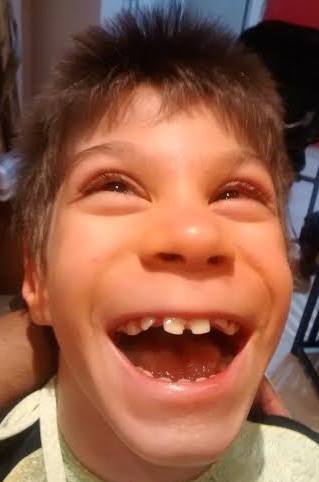
Date:2017-1-27
Susan te reitero el mail y necesito me confirmes dado que vamos a realizar el 3° Tratamiento de Tado en Abril de este año.
La fecha que estariamos llegando a Beijing sería entre el 22 y 24 de abril pero debo definir los vuelos todavia, vamos a estar por cuatro semanas.
Avisame por favor, muchos cariños y pronto nos vemos!
Natalia
